By Sean Pearson
With the new USSF mandated birth year and small sided games changes there is a lot of trial and error regarding formations and systems of play. Instead of 8v8 formations, as coaches, we are now trying to figure out how to position our players in the new 7 v 7 and 9 v 9 formations. Some clubs have an academy structure where all teams must play the same formation, others allow coaches to choose what works for their team because players in each team have different attributes.
In these Systems of Play articles, I aim to address a wide range of 7 v 7, 9 v 9 and 11 v 11 formations and ways in which to use your players to your advantage.
Formation
The 4-2-3-1 is a good formation to deny penetration from the other team in this low-pressure style due to the balance and positional sense of the formation. There are no gaps behind or to the side of players like the 4-3-3 or 4-4-2 (diamond) formation for other teams to exploit. Because there are players deeper and in front of the ball it is an easier system to utilize a low press.
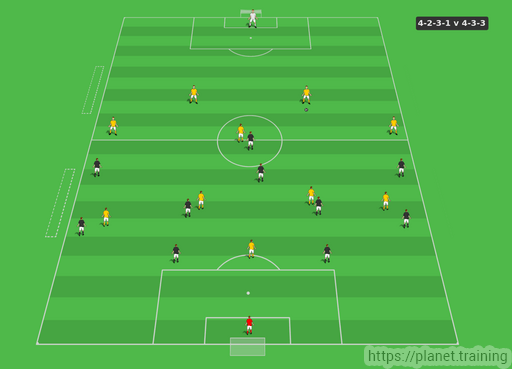
Denying Penetration at Mid-Field
If you want to be a successful team you need to be able to defend in different ways. You can’t just rely on one style of a high press or ‘park the bus’ mentality of defending for an entire game. Players get tired, the ball will be in various areas of the field and situations are different. So being able to defend in a different style is not only important but necessary.
When using this style of defending against a 4-3-3 your wingers need to ‘tuck in’ and become more connected with the central midfield 3. This increases the numbers in central areas and the difficulty of penetrating at the same time. The striker drops down to mark their defensive midfielder (#6) which leaves your attacking midfielder (#10) free. Your central midfielders mark theirs and the full back is tight to their wide striker, ball side, whilst the back 4 stay connected.
Because of these positions you are stopping the ball being played forward and frustrating them into sideways passes. Below we see the roles of players and the red passing lines signify passes that can’t be player without pressure or an interception.
- The striker is man marking the defensive midfielder, who has an extremely important role in the 4-3-3 by controlling the passing and the tempo of the team.
- The left defensive midfielder marks their right attacking midfielder ball side and anticipates the pass into feet so could step in to intercept the pass. The free #10 could also intercept the pass.
- The winger comes inside to stop any passes from the center back going to the attacking midfielders.
- The full back is touch tight on the wide striker and ready to anticipate any ball into their feet.
All these players in these certain positions frustrate the team in possession, making them unsure of making forward, penetrative passes, for fear of losing the ball, so the center back goes sideways instead.
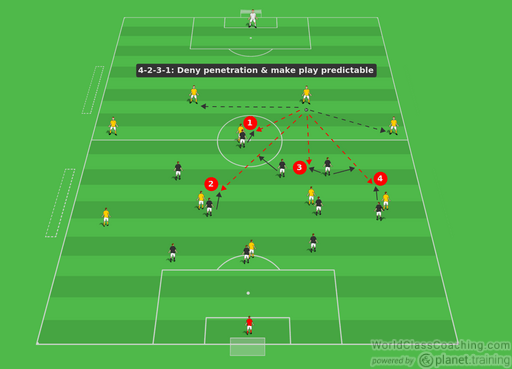
When the center back passes sideways, your players have to move in order to maintain denying penetration. As the ball is moving the winger on that side moves across to cut off the line to stop any forwards pass to the wide striker. Everyone slides across, with the resulting communication from the entire team of “slide/shift right”. Again, players are in positions to either cut off passes or be close enough to step in front of a pass. Therefore, the only pass that is not pressured is back towards the center back again. Now your team know where the ball is going this makes the team’s play predictable.
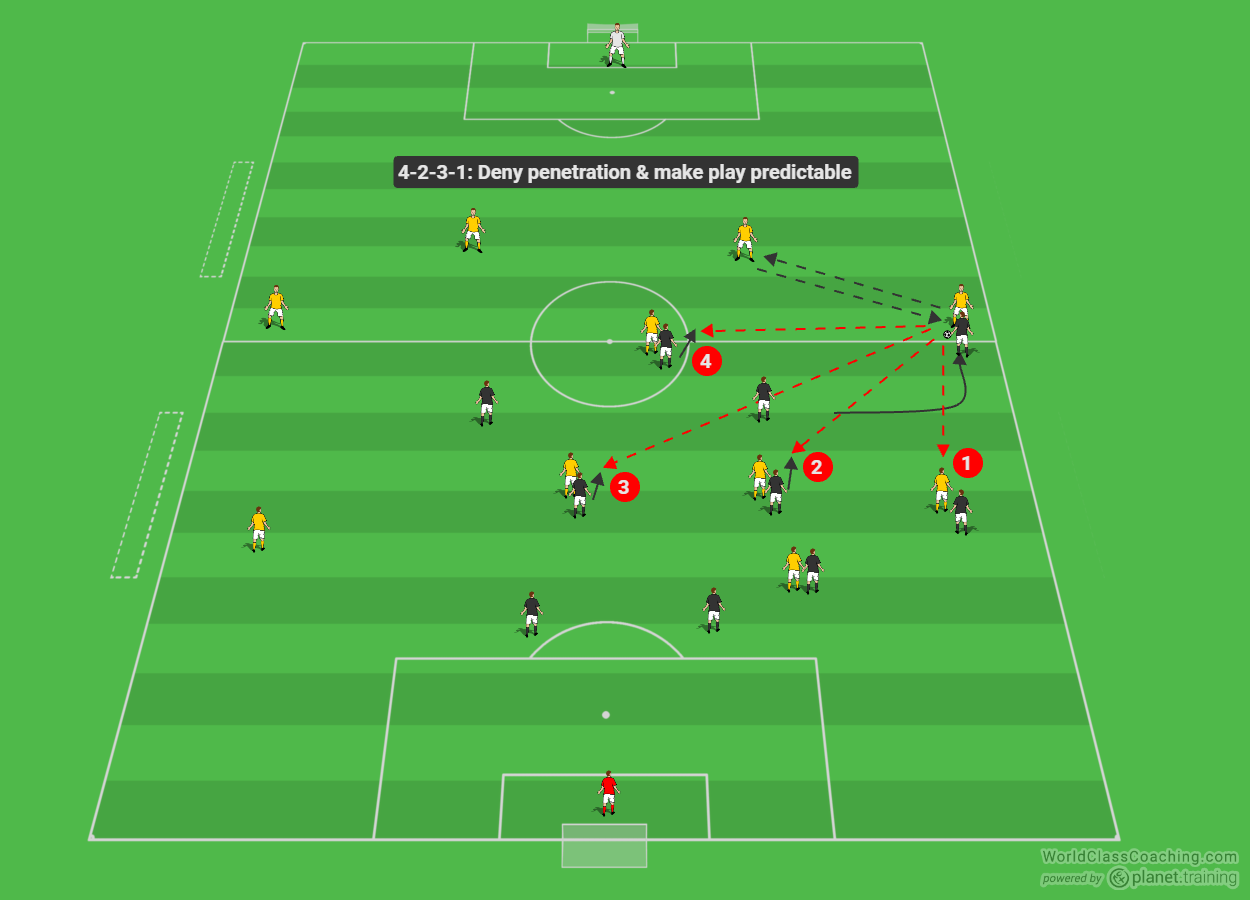
Eventually the center back will become bolder or the coach may tell them to come forwards with the ball. This could cause your team to panic because it is not something they may expect, so plan for it. This is the reason the striker has dropped down to mark the #6 and leaves your #10 free.
When the center back begins to venture forward, allow your #10 to press them from the front, this will have one of 3 things happen.
- They were not expecting this and panic into making a decision by passing forward. Your team should be aware this is an outcome and so anticipate this.
- They will turn and play backwards after seeing the pressure.
- They will lose control of the ball or the #10 will win the ball off of them.
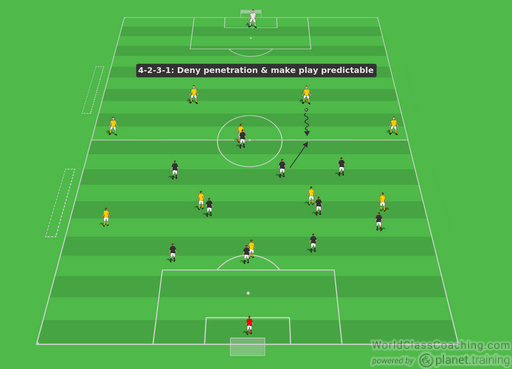
If the opposition try to switch the ball quickly and then bring the ball forwards, then because it is too far for the #10 to travel to keep up with the speed of the ball, so the striker (#9) presses from the front and the attacking midfielder (#10) takes their place in marking the #6.
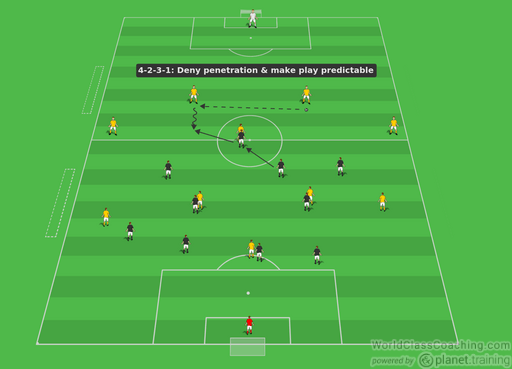
Eventually, if your team completes the task effectively, the opposing team will become more and more frustrated. Teams become impatient and will only go side to side a certain amount of times before attempting a long pass or something to beat the defensive shape. So, whether it be an entry pass into the midfield or a long ball over the top or a dribble forwards, your team must be prepared for every eventuality and your aim is obviously to win the ball.
By Sean Pearson. Sean is also the author Coaching Team Shape in the 3-3-1, Coaching Team Shape in the 4-2-3-1 and Coaching Team Shape in the 4-3-3


